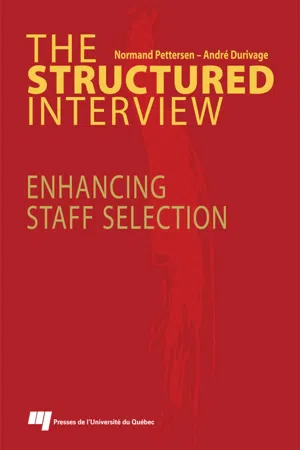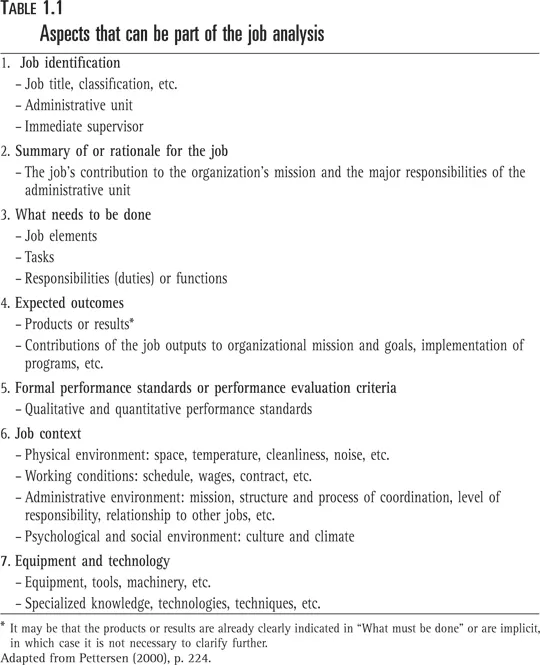THE SELECTION
INTERVIEW PROCESS
STEP 1
JOB ANALYSIS
A selection process must be based on an understanding of the job or group of jobs to be filled. With a structured job-related interview, the questions and the evaluation guide must as far as possible be based on the real nature of the job to be filled. To achieve this, an analysis of the job and its context must be done.
There is a great deal of documentation available. Job analysis is a huge specialty and many books have been written about it. We do not need to discuss all the knowledge and techniques in the field of job analysis here, but given its important role in preparing for and conducting an interview, a few elements bear review.
Definition. Job analysis is the process by which all the information about essential aspects of a job is gathered, including tasks, duties, responsibilities and working conditions. This analysis makes it possible to determine what the person in this position does at work, how the work is done, with whom, for whom, why and in what context, as well as the resources at the incumbent’s disposal. It has to take into account the scope and the level of the employee’s responsibilities. In certain circumstances, future duties and functions of the job as well as its more immediate needs must be taken into consideration.
Objective. In the selection context, a job analysis makes it possible to determine and understand all the aspects of a job or group of jobs in order to be able to define the selection criteria (the aspects to be evaluated in the candidates) in the following step. Therefore, you need a sound understanding of the tasks to be accomplished and the under-lying rationale in order to understand the desired performance and the competencies and qualities required in the candidate.
Job aspects to be analyzed. Table 1.1 presents the principle job aspects which can be analyzed. They do not all have to be analyzed to the same extent or in the same order as suggested here. The process needs to be adapted to the needs and constraints of the situation and the chosen approach.
The tasks to be carried out and the responsibilities to be assumed constitute “what needs to be done.? A responsibility or a function usually means a group of specific tasks. For example, the various tasks related to the budget (determining priorities, preparing the budget, controlling expenses) could constitute the “budget management» responsibility. A task is a group of job elements. The “budgetary control? task could include the following elements: approving expenses, recording the expenses under various budget items, etc. The tasks and responsibilities do not all have the same importance: their frequency (or duration) and their scope must be specified. Enquiring about the main problems encountered and their implications is one way of assessing the importance of these aspects. If the candidates must successfully complete a training program that they have not yet taken, the activities and other elements of this program must be part of the analysis.
Too often neglected in the job analysis, the other aspects presented in Table 1.1 must also be taken into consideration in order to draw a full picture of the ideal candidate. For example, the job context, particularly its administrative, psychological and social environment, will provide good indicators of the values and personality dimensions that will be required of the candidate.
Future needs. Future job needs, such as new technologies or long-term development programs, may also be taken into account. When it is clear that a job has a good chance of leading to a higher-level job, it may be appropriate to consider the tasks and responsibilities of this future job.
Limiting the analysis to a subset. The analysis does not necessarily deal with all the tasks or job aspects. In certain circumstances, it could be limited to the aspects that are suited to the measurement instrument to be used. For example, a department head’s job might include four areas of responsibility: a) strategic management, b) budgetary management, c) human resources management, and d) external communications. When designing the selection process, it could be decided that only candidates with accounting certification would be given an interview. Given this pre-selection criterion, it could also be decided not to evaluate certain aspects (e.g., budgetary management) in the interview. In this case, the job analysis for interview purposes could be limited to the three other areas of responsibility.
Methods and techniques for collecting information. To gather information on the various aspects of the job, several methods can be used. These include direct observation of people doing the job, individual interviews with these people or their supervisors, group interviews, questionnaires or keeping a journal. It might also be useful to consult existing job descriptions and other relevant documents (e.g., training manuals, the collective agreement). In short, any information that makes it possible to better understand the nature of the job to be done may be useful. Beyond these methods, various techniques are available, like the critical incident method (discussed later) and its variations, as well as many quantitative methods.
With regard to job descriptions available from the human resources department or elsewhere, it should be noted that these documents are often designed to establish the organization’s job classifications, not for determining required competences and others selection criteria. In addition, these job descriptions do not necessarily provide essential information, such as the way the job must be carried out, the expected outcomes or other organizational aspects like the company’s culture. These aspects can however influence the type and level of skills required, or other necessary personal qualities. In this regard, the incumbent or the immediate supervisor can represent a good source of information.
In practice, the investment needed for a job analysis will vary according to the circumstances. An important position, or a job occupied by a large number of people, may justify a more comprehensive analysis.
WRITING A JOB DESCRIPTION FOR SELECTION PURPOSES
Definition. When the job analysis is complete, it is convenient to gather all the information obtained in one document. This document constitutes the job description for selection purposes. The information presented can be structured in relation to the various aspects outlined in Table 1.1. Under “what needs to be done? (i.e., the tasks to be accomplished and the responsibilities to be assumed as part of the job), the information should be presented according to a logical structure, which for the most part is chronological or topical. Appendix A presents an example of a...

